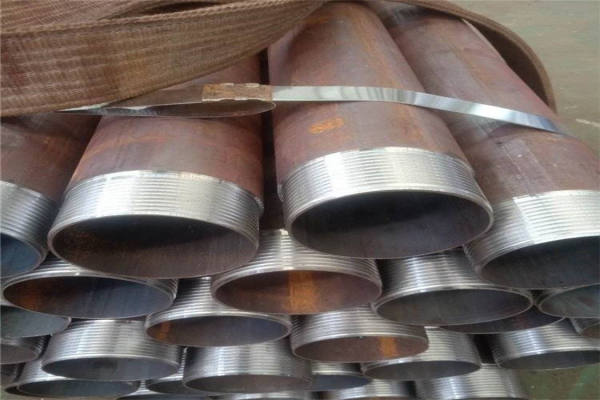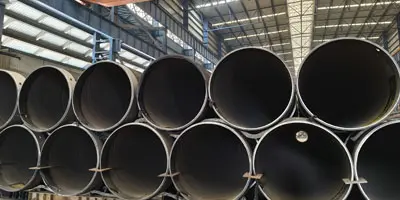There are many ways to connect steel pipes (seamless pipes, welded steel pipes, etc.), and the commonly used ones are: crimping, union, compression, push rod, tapered thread, socket welding, union flange connection, welding, and a series of connection methods that combine welding and traditional connection. Different connection methods have different production principles and different applicable fields, but in general, they all have one thing in common, that is, easy installation, firmness and reliability. You can choose a suitable connection method based on the actual situation, because the connection method also has certain requirements for the diameter of the steel pipe.
Seamless steel casing is directly connected by thread, and the male end is connected to the female end. The reliable sealing performance of the threaded part of the casing during connection is the key factor to ensure the normal production of the oil well.
The sealing structure of the new threaded oil casing adopts metal-to-metal contact sealing, which will not cause gap problems, so it has very reliable sealing performance; special threaded oil casing has been widely used in industrial equipment, especially in high-pressure oil and gas wells. However, these emerging threaded casings have very strict requirements on tightening torque, and generally have three values: maximum torque, optimal torque and minimum torque.
The three values of different threaded oil casing are also different. The range between the maximum torque and the minimum torque of some special threads is very small. In the actual oil casing operation, the tightening torque must be strictly within this range. If it exceeds the maximum torque value, the sealing surface of the threaded oil casing will be damaged. If it is less than the torque value, the metal sealing surface of the casing cannot be well in contact with the metal surface, and it will not play a sealing role at all, so you must pay attention to this when using it.

1. External thickening connection method: one end of the pipe is thickened with internal thread fasteners, and the other end is an external thread fastener. When connected together, the inner surface of the casing is smooth.
2. Direct connection method: Both ends of the pipe have internal and external threads, direct connection, and the inside and outside of the pipe are smooth.
3. Pipe connection method: Both ends of the pipe are internal thread buckles, and pipe connection is adopted. The outside is smooth after connection.
4. Coupling connection method: Both ends of the pipe are external thread fasteners, and external hoops are used for connection. After connection, the inside becomes a smooth surface. In addition, the method of welding oil casing joints has been recently adopted to make the inner surface of the pipe smooth after welding.
Threaded pipe connection
There are three ways to connect threaded pipes: cylindrical internal thread sleeve cylindrical external thread, cylindrical internal thread sleeve conical external thread, and conical internal thread sleeve conical external thread. The latter two methods are more tightly connected and are commonly used.
(1) Flanged flange connection. Flanged loose flanges are generally used for pipes of similar materials such as copper pipes, lead pipes, and plastic pipes. When flanging, different operation methods are selected according to different materials. The flanging is required to be flat and free of cracks and wrinkles.
(2) Threaded flange connection, using a flange with internal threads to connect a steel pipe with external threads. This type of flange is mostly made of cast iron and can be used to connect low-pressure pipelines.
(3) Welded flange connection. The flange and steel pipe are connected by welding. This flange connection is widely used. The welding method is: select a pair of flanges and install them on the two ends of the connected pipes respectively. If some equipment has flanges, flanges of the same specifications are selected for setting. First spot weld, correct the verticality, and finally weld the flange to the pipe firmly.
8 common connection methods for steel pipe construction
1. Threaded connection: suitable for galvanized steel pipes with a diameter less than or equal to 100mm, usually used for exposed steel pipes and steel-plastic composite pipes. The threaded part of the galvanized steel pipe must be treated with anti-corrosion, flanges or ferrule fittings can be used for connection, and the welds need to be galvanized twice.
2. Flange connection: suitable for large-diameter steel pipes, mostly used for main pipelines, connecting valves and other equipment. If galvanized pipes are used for welding joints, secondary galvanizing or anti-corrosion treatment should be performed.
3. Welding: suitable for non-galvanized steel pipes, often used for concealed pipelines and large-diameter steel pipes, especially in high-rise buildings. Pipes less than 22mm should be welded with socket or sleeve, and 2mm and above should be welded with butt welding. Socket welding can be used for stainless steel pipes.
4. Groove connection: suitable for galvanized steel pipes with a diameter greater than or equal to 100mm in fire water, air conditioning and water supply systems. It is easy to operate, safe to construct, convenient to maintain, and does not affect the original pipeline characteristics.
5. Ferrule connection: Aluminum-plastic composite pipes are usually crimped with threaded ferrules, and this method can also be used to connect copper pipes.
6. Compression connection: Stainless steel compression pipe fitting connection technology replaces the traditional connection method, and has the advantages of protecting water quality, corrosion resistance, and long service life. During construction, the pipe mouth is compressed by special tools to achieve reliable connection.
7. Hot melt connection: PPR pipes are connected using hot melt machines.
8. Socket connection: It is used to connect cast iron pipes and pipe fittings, and is divided into flexible and rigid connections. Flexible connections are sealed with rubber rings, while rigid connections use asbestos cement or expandable fillers. Lead seals can be used in important occasions.
In the use of seamless steel pipes, it is also necessary to pay attention to the various connection methods of seamless steel pipes.
When connecting seamless steel pipes, pay attention to the connection method to ensure the improvement of work efficiency. The commonly used seamless pipe connection methods are mainly the following:
1. Compression type: Put the pipe into the pipe fitting mouth, tighten it with a nut, and press the pipe mouth sleeve with spiral force through the sealing ring to play a sealing role and complete the connection of the pipe.
2. Welding type: open a groove at the end of the pipe, and weld the pipes together in a ring shape by manual or automatic welding.
3. Flange type: make a ring-shaped argon arc welding between the flange and the pipe, fasten it with a quick clamp or bolt, so that the gasket between the flanges plays a sealing role and completes the connection of the pipe.
4. Press-in type: insert the pipe into the pipe fitting, use a special installation tool to press the pipe wall into a hexagonal shape, and the inner sealing ring is also deformed into a hexagonal shape.
5. Cone thread type: the external thread and the pipe are connected by annular argon arc welding, and the conical thread is used to connect the internal thread pipe fitting to play a sealing role and complete the pipe connection.






 English
English Español
Español بالعربية
بالعربية











 Phone :
Phone :  Whatsapp :
Whatsapp :  Email :
Email : 


